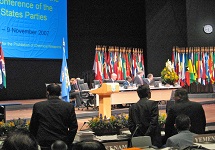Gabrielle Tarini
March 1, 2016
The following is an excerpt of an article published February 26 by New Century GeoStrategist.
The continued use of chemical weapons by state and non-state actors in the Middle East has weakened the norm against their use and threatens to undermine the utility of the Chemical Weapons Convention (CWC). For the CWC to remain a useful arms control tool, policymakers must find innovative ways to adapt the treaty to the shifting global security situation. Future actions must address President Assad’s continued violations of the CWC, verify the elimination of Syria’s chemical weapons program, and deal with chemical threats from non-state actors.
Challenge #1: Continued State Use of CW
Despite Syria’s accession to the CWC in 2013 and an unprecedented international effort to remove and destroy the majority of its declared chemical weapons program in 2014, the Assad regime continues to use chemicals as weapons in the broader Syrian conflict.
The Organization for the Prohibition of Chemical Weapons (OPCW) found that chlorine had been used in Syria “systematically and repeatedly” throughout 2014. Despite these conclusions, as well as condemnation from the OPCW Executive Council and the UN Security Council, chemical weapons use ramped up in Syria in 2015, with more than 30 alleged cases since March of 2015 alone.
The international community has been unable to verify the complete elimination of Syria’s chemical stockpile, and has expressed concern with the veracity of Syria’s initial chemical weapons declaration. The US assesses that Syria has not declared all of the elements of its chemical weapons program. Despite the creation of a specialized team and months of work by the OPCW to address gaps and inconsistencies in Syria’s declaration, numerous issues remain unresolved.

